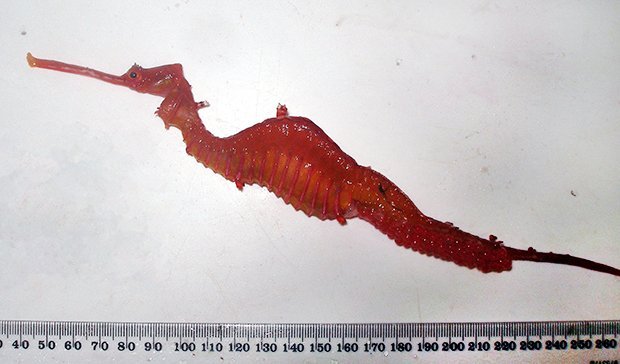Ruby seadragon Australia’s newest species

THE FIRST NEW Australian seadragon species to be declared in 150 years was hiding out in Perth’s Western Australian Museum (WAM).
The newly dubbed ruby seadragon (Phyllopteryx dewysea) – was thought to be the common seadragon (Phyllopteryx taeniolatus), until DNA sequencing on museum specimens revealed it was a distinct species.
While its ruby red colouring distinguishes it from other seadragons, “internally, there are several differences in the skeleton”, says Josefin Stiller, marine biology PhD student at the Scripps Institution of Oceanography, California.
Ruby seadragon discovery 100 years in the making
The four specimens used to describe the new species of seadragon included one picked up in 2007 off the Recherche Archipelago, east of Esperance, and another individual almost 100 years old, that washed up on Perth’s Cottesloe beach in 1919.
The specimens, stored in museum archives, some for decades, were initially mistaken for the common seadragon. It was not until Josefin and her team at Scripps Institute acquired a sample of tissue for DNA sequencing that the surprise find was made. Mitochondrial DNA analysis showed a 7.4 to 13.1% divergence from the other two species.
Josefin says the new species likely evaded discovery by living in waters deeper than those reachable by recreational SCUBA divers. “Our specimens of the new species were trawled from [depths of] fifty-one and seventy-two metres, a few kilometres off shore,” she says.
This behaviour differs from the ruby seadragons’ cousins, which prefer shallower coastal waters of depths between 4m to 40m.
The unusual colouration of the new species, Josefin says, could be an indicator of the ruby seadragon’s deeper marine habitat preference. “We propose that the red colour of the ruby seadragon helps to camouflage it at depth, as red light does not penetrate very well, so anything that is red is effectively black”, she says.
New seadragon species found in the archives
The species is the second in recent times to be discovered by chance from the study of old museum specimens.
These collections are “time capsules of discovery”, says Nerida Wilson, a senior research scientist at WAM. “Collections are safe-holdings for future generations, generations that will be exposed to new technologies that will enable them to further understand the evolution of such well-preserved specimens.”
The fascinating finding has prompted future research plans for scientists to observe the ruby seadragon in the wild. There is very little understanding of its habitat, and more importantly, missing pieces of the seadragon’s anatomical puzzle remain; all 4 collected individuals were devoid of appendages.
“Other [seadragon] species have leafy appendages to help them camouflage in kelp forests and seagrass, but in deeper habitats there is less light, and less algae and plants, as a result perhaps the species don’t have leafy appendages like their cousins”, says Nerida.

